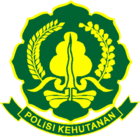Indonesia Forest Rangers
The Indonesian Forest Rangers (Indonesian: Polisi Kehutanan Indonesia (Indonesian Forest Police) abbreviated "Polhut") is a park ranger civil service within the Ministry of Environment and Forestry of Indonesia. It serves on a national and regional level in the country. Polhut is a dedicated unit in the Ministry of Environment and Forestry to preserve and protect forest within its authority given by law in forestry and wildlife.[1] Despite having the word Polisi, translated as "police", on its name, Polhut is not part of the Indonesian National Police (Polri).
| Indonesia Forest Rangers Polisi Kehutanan Indonesia | |
|---|---|
 Logo of Polhut | |
| Abbreviation | Polhut |
| Agency overview | |
| Formed | 28 May 1999 |
| Jurisdictional structure | |
| Operations jurisdiction | Indonesia |
| Specialist jurisdiction |
|
| Operational structure | |
| Parent agency | Ministry of Environment and Forestry |
History
Before the colonization period of the Netherlands (before 1592), there was no dedicated unit acting as park ranger. However, the function was already covered in customary law and local culture and tradition in preserving and protection forest and its wildlife; these were already done from generation to generation.[2]
Dedicated personnel as park rangers were created, Pengalasan, during the colonization period of the Netherlands. In 1620, formal rules were introduced, including prohibitions against cutting down forest trees without permits, and the introduction of Boswaker, whose main purpose was to help Pengalasan in preserving and protecting the forest. In 1870, an agrarian law to define the forest area was introduced. A year later, an official park ranger named Boschwacter was formed with the main task of overseeing any forest boundary violations. The first park ranger school was established in Madiun in 1941.[2]
During the colonization period of Japan, the park ranger school in Madiun was closed and re-established in October 1943 as Sinrin Keisatsu Gakkou to train Mantri Polisi Kehutanan, which originated from Boswaker and Pengalasan. During this period the park rangers were heavily trained in the military style.[2]
15 years after the independence of Indonesia, Director I Perhutani Central Java (now, Perhutani Unit I Central Java) with Commander of Police 94 Pati considered that it was necessary to form the park ranger police Polisi Chusus Kehutanan (PCK), or Special Forest Police, to tackle security disturbance in the forest within former Keresidenan Pati Central Java.[2]
Minister of Agriculture Decree No 194/Kpts/Um/3/1982 dated 27 March 1982 regarding Special Forestry Police for all Indonesia was issued. The decree also defined the difference between Special Forestry Police and Special Forest Police (for Perhutani territory only). Minister of Forestry Decree No 471/Kpts-II/1988 dated 30 September 1988, formally revised the Special Forestry Police's name to be JAGAWANA. Minister of Forestry Decree No 378/Kpts-V/1999 dated 28 Mei 1999, retracted the previous decree and revised the name of JAGAWANA to be POLISI KEHUTANAN, abbreviated POLHUT.[2]
Task and function
POLHUT have three main tasks, which are preemptive, preventive and repressive actions.[1]
Preemptive
Preemptive actions' primary purpose is to prevent, reduce, and eliminate the intent of any person or group to perform forestry crimes. Such actions are as follows:
- Public awareness and counseling
- Guidance and community awareness
Preventive
Preventive action is any action in order to prevent, reduce, or eliminate any possibility of any person or group to perform forestry crimes. Such action are as follows:
- Forest patrol
- Guard certain areas
- Identification of threats, security problems, or crime potency
Repressive
Repressive actions consist of but not limited to:
- Law enforcement operations
- Evidence gathering
- Securing evidence
- Suspect arrest operations
- Wildlife conflicts
- Firefighting
- Suspect, witness or evidence escort
Organization
POLHUT organization[2] consists of:
- POLHUT Pusat (National Forest Rangers)
- POLHUT Daerah (Regional Forest Rangers)
- Polhutsus Perhutani (Polisi Kehutanan Khusus Perhutani (forest rangers for Perhutani, whereas Perhutani is a state-owned enterprise which has the duty and authority to manage the state forest resources in Java and Madura)[3]
POLHUT has its own rapid response unit formed in 2005, named SPORC (Satuan Polhut Reaksi Cepat)[4], translated as POLHUT's rapid response unit. Based on Minister of Forestry decree No.P.75/Menhut-II/2014 regarding POLHUT, SPORC is a unit within POLHUT with enhanced qualification to overcome forestry security issues in an efficient, effective and accurate manner.[2]
Weapons
POLHUT officers are trained in the use of firearms for protection. Semi-automatic pistols are issued to most units. SPORC officers are also trained in the use of shotguns and sub-machine guns.
- CZ 83[5] – standard issue sidearm
- PM1 A1[5] – standard issue SMG, locally manufactured Beretta M12 by Pindad under license
- Vepr-12 – standard issue shotgun
References
- "Peraturan Menteri Kehutanan Republik Indonesia No P.75/Menhut-II/2014 Tentang Polisi Kehutanan" (PDF). Kementerian Kehutanan (in Indonesian). ditjenpp kemenkumham. 22 September 2014. Retrieved 8 January 2020.
- Ridholof, Hermanus (May 2016). "Kewenangan Polisi Kehutanan Dalam Bidang Perlindungan Hutan Pada Pemerintah Daerah di Sulawesi Tengah" [Authority of Forest Ranger in Forest Protection within Central Sulawesi] (PDF). e Jurnal Katalogis (in Indonesian). 4 (5): 196-208. ISSN 2302-2019. Retrieved 8 January 2020.
- "Profil Perusahaan Perum Perhutani". perhutani.co.id (in Indonesian). 16 November 2019. Retrieved 8 January 2020.
- Tangngalangi, Muhammad Ashlam; Kartodihardjo, Hariadi; Ichwand, Iin (April 2014). "Analisis Kebijakan Pembentukan SPORC dan Implementasinya dalam Pemberantasan Ilegal Loging di Indonesia (Studi Kasus di Sulawesi Selatan)" [Policy Analysis of SPORC Establishment and Its Implementation to Control Illegal Logging in Indonesia (Case Study in South Sulawesi)]. Jurnal Analisis Kebijakan Kehutanan (in Indonesian). 11 (1): 1-24. doi:10.20886/jakk.2014.11.1.1-24. Retrieved 8 January 2020.
- "Statistik 2016 BKSDA Jawa Timur" (PDF). BKSDA Jawa Timur. February 2017. p. 44. Retrieved 8 January 2020.
External links
- (in Indonesian) Kementerian Kehutanan dan Lingkungan Hidup